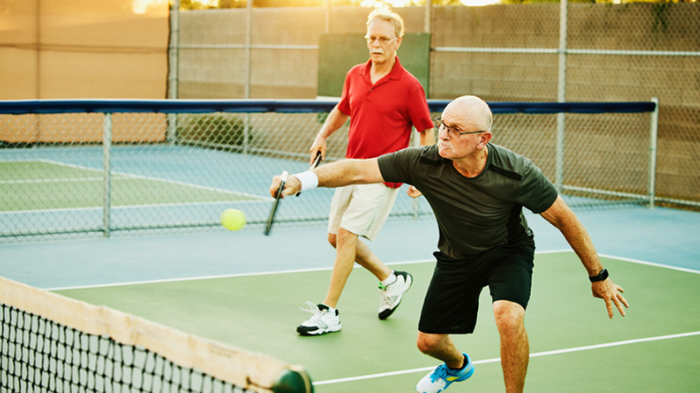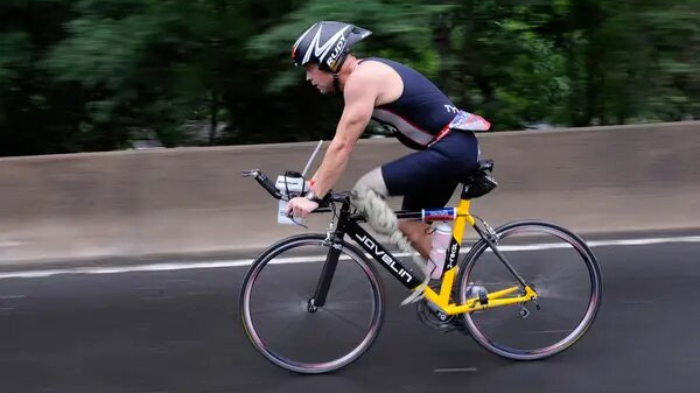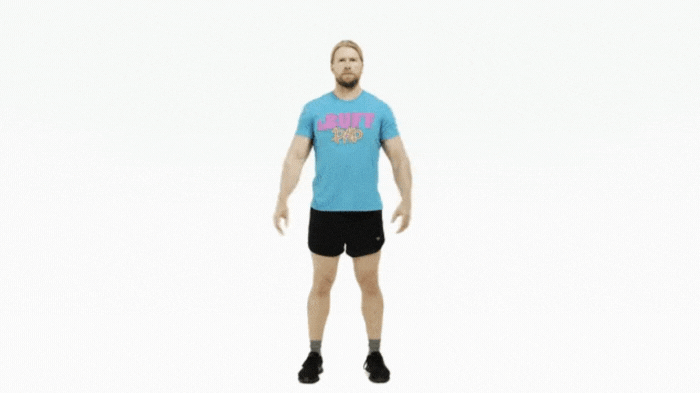To excel in pickleball, it is important to focus not only on practicing the game itself but also on incorporating cross-training exercises into your routine. Cross-training involves engaging in various activities that target different muscle groups and aspects of fitness. Many pickleball players have the question in their mind, “How to Cross-Train for Pickleball?”
In this blog post, we are going to explain various cross training exercises that pickleball players can practice in their routines and how to create your own cross-training plan. We are also going to explain the importance of crosstraining for improving your pickleball performance. Read this blog, create your cross train workout routines plan, and start doing cross-training exercises.

Importance of Cross-Training for Improved Performance in Pickleball
Cross-training refers to the practice of engaging in different forms of physical activity or training to enhance overall performance in a specific sport or activity. In pickleball, cross-training can play a crucial role in improving performance and achieving better results. Here are some key reasons why cross-training is important for enhanced performance in pickleball:
Physical Conditioning: In pickleball, you need a mix of aerobic endurance, agility, strength, and flexibility. Participating in cross-training activities such as running, cycling, swimming, or weightlifting can boost your cardiovascular fitness, strengthen your muscles, and enhance your overall physical condition. These improvements are essential for performing at your best and achieving success in pickleball. By targeting various muscle groups and energy systems, cross-training improves your physical abilities and equips you to meet the challenges of pickleball.
Injury Prevention: Repetitive movements in any sport can result in repetitive strain injuries. Nevertheless, by including cross-training activities that encompass a wide range of movement patterns and target different muscle groups, you can decrease the probability of such injuries during your pickleball sessions. For example, if pickleball predominantly involves lateral movements, incorporating activities like yoga, pilates, or resistance training can improve stability, flexibility, and balance, reducing the likelihood of muscle imbalances and injuries.
Skill Transfer: Cross-training can aid in developing skills that can be applied to pickleball. For instance, activities like tennis, badminton, or table tennis share similarities with pickleball in terms of hand-eye coordination, reaction time, and racket skills. By participating in these related sports, you can enhance your coordination, reflexes, and anticipation, which can directly benefit your performance in pickleball.
Mental Adaptability: Cross-training not only improves physical attributes but also promotes mental adaptability. Engaging in diverse activities challenges your brain to learn new skills, adapt to different environments, and make quick decisions. This mental flexibility can be beneficial in pickleball, where you need to react to varying situations, adjust your strategies, and make split-second decisions on the court.
Break From Monotony: Cross-training adds variety to your training routine, preventing monotony and burnout. Participating in various activities helps you stay motivated because you have a broader selection of options to make your workouts enjoyable. This psychological aspect can positively impact your overall performance and long-term commitment to pickleball.
Overall Fitness: Cross-training improves your overall fitness levels by targeting different aspects of physical fitness. By diversifying your training regimen, you can improve your cardiovascular endurance, muscular strength, power, agility, speed, and flexibility. This comprehensive approach to fitness enhances your overall athleticism, making you a more well-rounded and capable pickleball player.
Cross-Training Exercises for Pickleball Players
Cross-training exercises for pickleball players can be an excellent way to enhance overall fitness, improve performance, and prevent injuries. Here is a detailed explanation of different types of cross-training exercises that can benefit pickleball players in cardiovascular endurance, strength training, flexibility and balance, agility and quickness, and reaction time.
Cardiovascular Endurance
Cardiovascular endurance exercises focus on improving the efficiency of the cardiovascular system, enhancing stamina, and sustaining physical activity for extended periods. Examples of cardio exercises suitable for pickleball players include:
- Running Or Jogging: Consistent running or jogging sessions significantly improve overall endurance and cardiovascular fitness.
- Cycling: Whether you prefer cycling indoors using a stationary bike or opt for an outdoor bike ride, cycling is a low-impact cardio exercise that effectively improves your endurance.

- High-Intensity Interval Training (HIIT): HIIT involves alternating between intense bursts of exercise and short recovery periods. This type of training can be particularly beneficial for pickleball players, as it simulates the quick bursts of energy required during the game.
Strength Training
Strength training exercises are vital for pickleball players as they significantly improve power, stability, and overall strength, which are fundamental for optimal performance in the pickleball game. How to improve focus in pickleball? Some effective strength training exercises include:
- Squats: Squats focus on the lower body muscles, such as the quadriceps, hamstrings, and glutes, which aids in enhancing leg strength and stability.
- Lunges: Lunges target important leg muscles such as the quadriceps, hamstrings, and calves. By incorporating lunges into your exercise routine, you can strengthen your lower body and improve your balance at the same time.
- Deadlifts: Deadlifts primarily engage the muscles in the back, hips, and legs, promoting comprehensive strength and stability throughout the body.
- Core Exercises: Engaging in exercises such as planks, Russian twists, and sit-ups can strengthen the core muscles, enhancing stability and power during pickleball movements.
Agility & Quickness
Agility and quickness exercises focus on improving the ability to change direction rapidly, react swiftly, and move with speed. Key exercises for agility and quickness include:
- Ladder Drills: Utilizing an agility ladder for exercises like lateral runs, high knees, and quick feet drills can improve footwork and agility.
- Cone Drills: Setting up cones in various patterns and performing quick movements around them can enhance agility, speed, and directional changes.
- Shuttle Runs: Setting up markers at various distances and performing shuttle runs or sprints can enhance speed, agility, and endurance.
Reaction Time
Reaction time exercises aim to enhance the ability to react quickly to stimuli, such as a ball being hit during a pickleball game. Some exercises to improve reaction time include:
- Ball Drills: Engaging in drills with a partner or against a wall that involves tossing or hitting balls in different directions can improve your response time. These exercises require you to react quickly, which helps you to become more responsive during pickleball games.
- Visual Reaction Training: Using reaction balls or lights that require rapid response to visual cues can enhance reaction time.
- Agility Ladder Drills With Random Cues: Incorporating random visual or auditory cues during ladder drills can improve reaction time and decision-making.
Flexibility & Balance
Flexibility and balance exercises aid in injury prevention, range of motion, and fluid movements on the pickleball court. Some exercises to improve flexibility and balance include:
- Yoga Or Pilates: Taking part in yoga or Pilates classes can improve your flexibility, core strength, and balance. These activities provide a range of benefits, including increased flexibility, improved core strength, and enhanced balance.
- Dynamic Stretches: Performing dynamic stretches such as leg swings, arm circles, and torso twists can help to warm up the muscles and improve flexibility.

- Single-Leg Balance Exercises: Standing on one leg while performing exercises like leg raises or single-leg squats can enhance balance and stability.
Remember to consult with a fitness professional or coach to design a cross train workout routines program that suits your specific needs and goals. Additionally, always prioritize safety, warm up adequately before exercising, and listen to your body to avoid overexertion and injuries.
Read About:Pickleball nutrition And Beer city pickleball 2023
How to Create Your Cross-Training Plan?
Creating a cross-training plan involves considering your fitness goals, assessing your current fitness level, selecting appropriate activities, scheduling workouts, and tracking progress. Here’s a step-by-step guide with a practical example to help you create your own cross-training plan:
Step 1: Define Your Goals
Identify your specific goals for cross-training. For example, your goals include improving cardiovascular endurance, increasing strength, enhancing flexibility, and boosting agility for pickleball.
Step 2: Assess Your Fitness Level
Evaluate your current fitness level and identify areas that require improvement. Assess your cardiovascular endurance, strength, flexibility, balance, agility, and reaction time. This self-assessment will help you to target your weak areas effectively.
Step 3: Select Cross-Training Activities
Choose a variety of activities that align with your goals and cater to different aspects of fitness. Consider activities like running, cycling, swimming, strength training, yoga, pilates, agility ladder drills, and reaction time exercises.
Example:
- Cardiovascular Endurance: Running and cycling.
- Strength Training: Bodyweight exercises, weightlifting, and resistance training.
- Flexibility & Balance: Yoga, Pilates, and dynamic stretching.
- Agility & Quickness: Agility ladder drills and cone drills.
- Reaction Time: Ball drills and visual reaction training.
Step 4: Design Your Schedule
Determine the frequency and duration of your cross-training sessions. Aim for a balanced routine that includes a mix of activities to address different fitness components. Consider your availability and other commitments when creating your schedule.
Example:
- Monday: Strength training (45 minutes) + Yoga for flexibility (30 minutes).
- Tuesday: Cardiovascular endurance – Running (30 minutes).
- Wednesday: Rest day or light activity like walking or stretching.
- Thursday: Agility & Quickness – Agility ladder drills (20 minutes) + Reaction time – Ball drills (15 minutes).
- Friday: Cardiovascular endurance – Cycling (45 minutes) + Strength training (30 minutes).
- Saturday: Flexibility & Balance – Yoga or Pilates (45 minutes).
- Sunday: Rest day.
Step 5: Monitor And Track Progress
Make sure to keep a record of your workouts, including the exercises you perform, the duration of each session, the intensity level, and any progress or obstacles you encounter along the way. You can use a fitness journal, a mobile app, or a spreadsheet to track your cross-training activities. Regularly review your progress to stay motivated and make necessary adjustments to your plan.
Step 6: Gradually Increase Intensity And Variety
As you progress, gradually increase the intensity of your workouts, introduce new exercises or activities to prevent stagnation, and keep your routine challenging and engaging. By following these practices, you can keep progressing and avoid getting stuck in the stagnant phase of your fitness journey.
Step 7: Listen To Your Body And Adapt
Pay attention to the signals your body gives you and adjust your plan accordingly. Rest when needed, modify exercises if necessary, and consult a fitness professional or coach if you have any concerns or specific needs.
Remember, this is just a sample plan, and you should tailor it to your individual preferences and goals. It is always beneficial to consult with a fitness professional to create a personalized cross-training plan that suits your needs and helps you achieve optimal results.
FAQs
Yes, cross-training is beneficial for players of all levels, including beginners. Start with exercises that suit your current fitness level and gradually progress.
The frequency of cross-training depends on your schedule and fitness level. Aim for at least two to three cross-training sessions per week, in addition to regular pickleball practice.
Absolutely! The off-season is a valuable chance to prioritize cross-training. It gives you the opportunity to improve your physical fitness and maintain your overall fitness level even when you’re not actively playing pickleball.
Yes, cross-training can significantly improve your performance in pickleball. By targeting various aspects of fitness, such as cardiovascular endurance, strength, flexibility, agility, and reaction time, you can enhance your skills, stamina, power, and overall fitness level.
Although a personal trainer can offer valuable guidance and create a customized plan for you, it is not essential to hire one. You can find plenty of online resources, workout videos, and mobile apps that provide guidance and instructions for crosstraining exercises. However, if you have specific questions or prefer individualized guidance, collaborating with a personal trainer can be beneficial.
Conclusion
Incorporating cross-training exercises into your pickleball routine is crucial for overall improvement and performance enhancement. By diversifying your workouts, you can enhance your physical conditioning, prevent injuries, transfer skills, and maintain mental adaptability.
How to Cross-Train for Pickleball? You can cross train for playing pickleball by creating your cross-training plan and by practicing crosstraining exercises like cardiovascular endurance exercises, strength training exercises, flexibility and balance exercises, agility and quickness exercises, and reaction time exercises. After writing this blog, we suggest you to create your cross training exercises plan, follow them, practice crosstraining exercises according to your planned schedule, and you will definitely rock yourself in the pickleball court.



